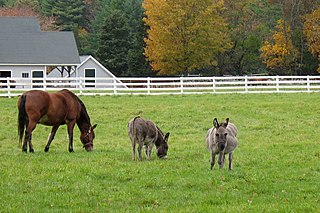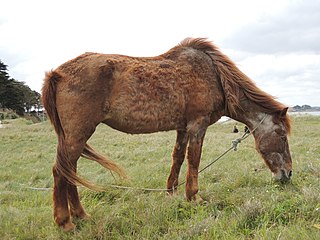
A draft horse (US) or draught horse (UK), also known as dray horse, carthorse, work horse or heavy horse, is a large horse bred to be a working animal hauling freight and doing heavy agricultural tasks such as plowing. There are a number of breeds, with varying characteristics, but all share common traits of strength, patience, and a docile temperament.
Colic in horses is defined as abdominal pain, but it is a clinical symptom rather than a diagnosis. The term colic can encompass all forms of gastrointestinal conditions which cause pain as well as other causes of abdominal pain not involving the gastrointestinal tract. What makes it tricky is that different causes can manifest with similar signs of distress in the animal. Recognizing and understanding these signs is pivotal, as timely action can spell the difference between a brief moment of discomfort and a life-threatening situation. The most common forms of colic are gastrointestinal in nature and are most often related to colonic disturbance. There are a variety of different causes of colic, some of which can prove fatal without surgical intervention. Colic surgery is usually an expensive procedure as it is major abdominal surgery, often with intensive aftercare. Among domesticated horses, colic is the leading cause of premature death. The incidence of colic in the general horse population has been estimated between 4 and 10 percent over the course of the average lifespan. Clinical signs of colic generally require treatment by a veterinarian. The conditions that cause colic can become life-threatening in a short period of time.

Laminitis is a inflammation of laminae that affects the feet of ungulates and is found mostly in horses and cattle. Clinical signs include foot tenderness progressing to inability to walk, increased digital pulses, and increased temperature in the hooves. There is also swelling in foot in some cases.Severe cases with outwardly visible clinical signs are known by the colloquial term founder, and progression of the disease will lead to perforation of the coffin bone through the sole of the hoof or being unable to stand up, requiring euthanasia.

Equine exertional rhabdomyolysis (ER) is a syndrome that affects the skeletal muscles within a horse. This syndrome causes the muscle to break down which is generally associated with exercise and diet regime. Depending on the severity, there are various types of ER, including sporadic and chronic.

There are many aspects to horse management. Horses, ponies, mules, donkeys and other domesticated equids require attention from humans for optimal health and long life.
Grass sickness, alternatively termed equine dysautonomia, is a rare but predominantly fatal illness in horses. Grass sickness may affect all types of horse, pony and donkey, and has affected some well known horses including the thoroughbred stallions Dubai Millennium, Moorestyle and Mister Baileys.
Equine polysaccharide storage myopathy is a hereditary glycogen storage disease of horses that causes exertional rhabdomyolysis. It is currently known to affect the following breeds American Quarter Horses, American Paint Horses, Warmbloods, Cobs, Dales Ponies, Thoroughbreds, Arabians, New Forest ponies, and a large number of Heavy horse breeds. While incurable, PSSM can be managed with appropriate diet and exercise. There are currently 2 subtypes, known as Type 1 PSSM and Type 2 PSSM.

Equine nutrition is the feeding of horses, ponies, mules, donkeys, and other equines. Correct and balanced nutrition is a critical component of proper horse care.

Stable vices are stereotypies of equines, especially horses. They are usually undesirable habits that often develop as a result of being confined in a stable with boredom, hunger, isolation, excess energy, or insufficient exercise. They present a management issue, not only leading to facility damage from chewing, kicking, and repetitive motion, but also leading to health consequences for the animal if not addressed. They also raise animal welfare concerns.

Equine metabolic syndrome (EMS) is an endocrinopathy affecting horses and ponies. It is of primary concern due to its link to obesity, insulin dysregulation, and subsequent laminitis. There are some similarities in clinical signs between EMS and pituitary pars intermedia dysfunction, also known as PPID or Cushing's disease, and some equines may develop both, but they are not the same condition, having different causes and different treatment.

A hard keeper or poor doer is a horse or other livestock animal that is naturally prone to be thin, will lose weight quickly, and has difficulty gaining weight.

A yearling is a young horse either male or female that is between one and two years old. Yearlings are comparable in development to a very early adolescent and are not fully mature physically. While they may be in the earliest stages of sexual maturity, they are considered too young to be breeding stock.

Mountain and moorland ponies form a group of several breeds of ponies and small horses native to the British Isles. Many of these breeds are derived from semi-feral ponies kept on moorland or heathland, and some of them still live in this way, as well as being kept as fully domesticated horses for riding, driving, and other draught work, or for horse showing.

A pony is a type of small horse. Depending on the context, a pony may be a horse that is under a given height at the withers, or a small horse with a specific conformation and temperament. Compared to a larger horse, a pony may have a thicker coat, mane and tail, with proportionally shorter legs, a wider barrel, heavier bone, a thicker neck and a shorter, broader head. The word pony derives from the old French poulenet, meaning foal, a young, immature horse.

Natural hoof care is the practice of keeping horses so that their hooves are worn down naturally, or trimmed to emulate natural wear, so they do not suffer overgrowth, splitting and other disorders. Horseshoes are not used, but domesticated horses may still require trimming, exercise and other measures to maintain a natural shape and degree of wear.

This is a basic glossary of equestrian terms that includes both technical terminology and jargon developed over the centuries for horses and other equidae, as well as various horse-related concepts. Where noted, some terms are used only in American English (US), only in British English (UK), or are regional to a particular part of the world, such as Australia (AU).

The Henneke horse body condition scoring system is a numerical scale used to evaluate the amount of fat on a horse's body. It was developed in the early 1980s by Don Henneke at Texas A&M University with the goal of creating a universal scale to assess horses' bodyweight, and was first published in 1983. It is a standardized system that can be used across all breeds without specialized equipment; condition is assessed visually and by palpation. Scores range from 1 to 9 with 1 being poor and 9 being extremely fat; the ideal range for most horses is from 4 to 6. The system is based on both visual appraisal and palpable fat cover of the six major points of the horse. The system is used by law-enforcement agencies as an objective method of scoring a horse's body condition in horse cruelty cases.

Pituitary pars intermedia dysfunction (PPID), or equine Cushing's disease, is an endocrine disease affecting the pituitary gland of horses. It is most commonly seen in older animals, and is classically associated with the formation of a long, wavy coat (hirsutism) and chronic laminitis.

A geriatric horse is an equine that may show signs of physical and mental decline, which generally limits its ability to participate in most equestrian activities. The age at which a horse is considered geriatric can vary by breed and intended use, with older age being reached more quickly in Thoroughbred sport horses than in more robust ponies. Common signs of geriatric horses include dental changes, graying of certain areas on the head, a pronounced arch in the back, and stiffness in movement. Additionally, these animals may become more sensitive to seasonal changes.

The horse body mass is highly variable, depending on breed, model, physiological state, condition, owner's purpose and usage of the animal. Always 65 % to 75 % water, it is divided on average between 50 % muscle, 11 % bone and 10 % fat. Depending on whether it's a pony or a draft horse, it can range from less than 200 kg to over a ton, with an average of 500 kg for saddle horses. It also differs with the season, as horses are almost always fatter in summer than in winter. Various tools are used to estimate their weight and body condition, and veterinary scales have been created to determine whether a horse has an ideal body mass according to precise criteria. Thinness is associated with mistreatment, but owner-independent factors such as age and illness can cause dramatic weight loss in horses. In Western countries, equine obesity is one of the major veterinary health problems of the 21st century. It is directly linked to numerous pathologies, such as laminitis, osteoarthritis, insulin resistance and colic. It also favors the development of equine Cushing's disease, and causes a drop in stallion fertility.
















